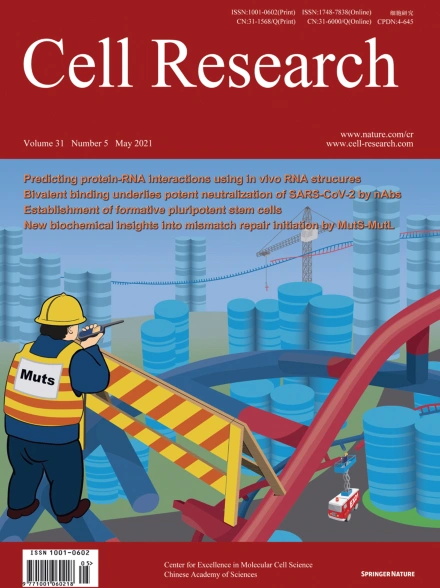
Advanced Search
Submit Manuscript
Advanced Search
Submit Manuscript
Volume 31, No 5, May 2021
ISSN: 1001-0602
EISSN: 1748-7838 2018
impact factor 17.848*
(Clarivate Analytics, 2019)
Volume 31 Issue 5, May 2021: 517-525 |
Structural basis for bivalent binding and inhibition of SARS-CoV-2 infection by human potent neutralizing antibodies
Renhong Yan1,2 , Ruoke Wang3,4 , Bin Ju5,6 , Jinfang Yu7,8,9,10 , Yuanyuan Zhang1,2 , Nan Liu4,7,8,10 , Jia Wang4,7,8,11 , Qi Zhang3 , Peng Chen3 , Bing Zhou5,6 , Yaning Li4,8,10 , Yaping Shen1,2 , Shuyuan Zhang7,8,9,10 , Long Tian7,8,9,10 , Yingying Guo1,2 , Lu Xia1,2 , Xinyue Zhong1,2 , Lin Cheng5 , Xiangyang Ge5 , Juanjuan Zhao5,11 , Hong-Wei Wang7,10 , Xinquan Wang7,8,9,10 , Zheng Zhang5,6,* , Linqi Zhang3,* , Qiang Zhou1,2,*
1Center for Infectious Disease Research, Westlake Laboratory of Life Sciences and Biomedicine, Key Laboratory of Structural Biology of Zhejiang Province, School of Life Sciences, Westlake University, 18 Shilongshan Road, Hangzhou, Zhejiang 310024, ChinaNeutralizing monoclonal antibodies (nAbs) to severe acute respiratory syndrome coronavirus 2 (SARS-CoV-2) represent promising candidates for clinical intervention against coronavirus disease 2019 (COVID-19). We isolated a large number of nAbs from SARS-CoV-2-infected individuals capable of disrupting proper interaction between the receptor binding domain (RBD) of the viral spike (S) protein and the receptor angiotensin converting enzyme 2 (ACE2). However, the structural basis for their potent neutralizing activity remains unclear. Here, we report cryo-EM structures of the ten most potent nAbs in their native full-length IgG-form or in both IgG-form and Fab-form bound to the trimeric S protein of SARS-CoV-2. The bivalent binding of the full-length IgG is found to associate with more RBDs in the “up” conformation than the monovalent binding of Fab, perhaps contributing to the enhanced neutralizing activity of IgG and triggering more shedding of the S1 subunit from the S protein. Comparison of a large number of nAbs identified common and unique structural features associated with their potent neutralizing activities. This work provides a structural basis for further understanding the mechanism of nAbs, especially through revealing the bivalent binding and its correlation with more potent neutralization and the shedding of S1 subunit.
https://doi.org/10.1038/s41422-021-00487-9